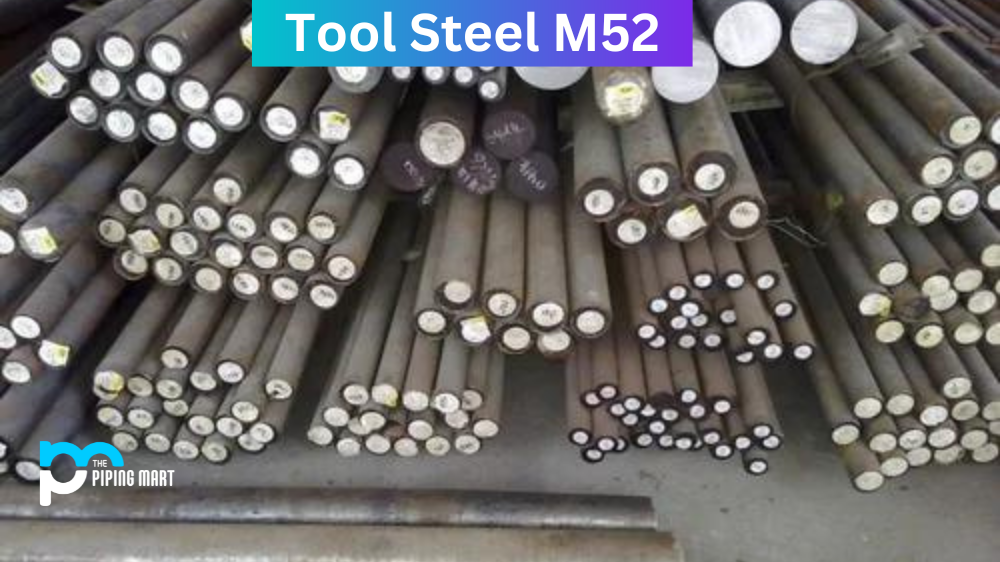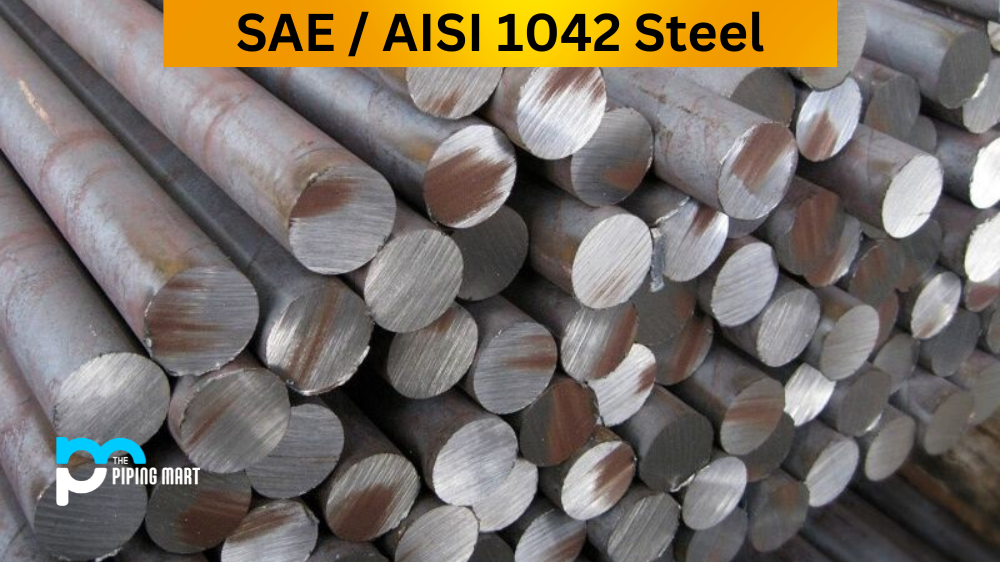Tool steel is a type of carbon steel alloy with a higher content of carbon. It’s known for its hardness and strength, which makes it an ideal material for tools used in various industries such as automotive, manufacturing, aerospace, and engineering. One popular tool steel is M52—but what exactly is Tool Steel M52? Let’s take a look at its composition, mechanical properties, physical properties, uses, corrosion resistance, heat resistance, and heat treatment processes.
Composition
The chemical composition of Steel M52 is 0.80% Carbon (C), 2.00% Chromium (Cr), 3.50% Nickel (Ni), 0.90% Molybdenum (Mo), 0.20% Manganese (Mn), 4 .00 % Silicon (Si). This chemical composition provides excellent toughness and wear resistance, making it suitable for many applications, including high-pressure dies and cold work punches.
| C | Si | Mn | P | S | Cr | Mo | V | W | Co |
| 0.85~0.95 | 0.20~0.60 | 0.15~0.45 | 0.030 max | 0.030 max | 3.50~4.30 | 4.00~4.90 | 1.65~2.25 | -0.75~1.50 | – |
Tool Steel M52 uses
Alloy M52 is renowned for its hardness, durability, and corrosion resistance, making it an ideal material for a range of uses. In particular, tool steel M52 is often used in the production of knives, punching tools, and shear blades due to its excellent edge retention and strength. These tools are heavily relied on in industries such as manufacturing and construction. Furthermore, tool steel M 52 can be used in situations where contact with water needs to be avoided due to its high resistance to rust and oxidation. Due to these qualities, this material can also be used for items like press screws and electrical connectors, which require additional protection from moisture in order to function properly. Altogether, the many advantages of tool steel M52 make it an ideal choice for almost any application.
Mechanical Properties
The mechanical properties of M52 Tool Steel are impressive too! It has a yield strength of 1120 MPa (165 ksi) with an ultimate tensile strength of 1430 MPa (208 ksi). It also has a good impact toughness at -100°C (-148°F) with an Izod value of 55 J/cm2 (−20 ft-lb/in2). This combination makes it suitable for many applications, such as dies and punches that require high strength and good impact toughness.
| Properties | Metric | Imperial |
|---|---|---|
| Hardness, Rockwell C (oil quenched from 1175°C; 622°C temper temperature) | 54.5 | 54.5 |
| Hardness, Rockwell C (oil quenched from 1175°C; 482°C temper temperature) | 62.5 | 62.5 |
| Hardness, Rockwell C (oil quenched from 1175°C; 520°C temper temperature) | 63.5 | 63.5 |
| Izod impact unnotched (oil quenched at 1175°C; 482°C temper temperature) | 38.0 J | 28.0 ft-lb |
| Izod impact unnotched (oil quenched at 1175°C; 594°C temper temperature) | 59.7 J | 44.0 ft-lb |
| Izod impact unnotched (oil quenched at 1175°C; 622°C temper temperature) | 63.7 J | 47.0 ft-lb |
Physical Properties
In terms of physical properties, Tool Steel M52 can be machined easily due to its low coefficient of friction and excellent finish ability thanks to its smooth surface finish after machining. Its machinability rating is about 96%. It also has great polishing capability when properly heat treated or surface hardened so that it can be used in components that require good appearance or mirror-like finishes, such as in the medical device industry or aerospace components industry, where cosmetic appearance plays an important role in product quality assurance.
| Quantity | Value | Unit |
|---|---|---|
| Thermal expansion | 16 – 17 | e-6/K |
| Thermal conductivity | 16 – 16 | W/m.K |
| Specific heat | 500 – 500 | J/kg.K |
| Melting temperature | 1370 – 1400 | °C |
| Service temperature | – 500 | °C |
| Density | 8000 – 8000 | kg/m3 |
| Resistivity | 0.7 – 0.7 | Ohm.mm2/m |
Thermal Properties
| Properties | Conditions | ||
|---|---|---|---|
| T (°C) | Treatment | ||
| Thermal Conductivity (W/m-K) | 42.7 | 100 | |
| Specific Heat (J/kg-K) | 477 | 50-100 | |
Equivalent
| USA | Germany | China | Japan | France | England | Italy | Poland | Czechia | Austria | Sweden | Spain |
| AISI/SAE/UNS/ASTM | DIN,WNr | GB | JIS | AFNOR | BS | UNI | PN | CSN | ONORM | SS | UNE |
| M52/UNS T111350/A600 | BM52 |
Corrosion Resistance
Tool Steel M52 is often used in valve parts where corrosion resistance is necessary due to contact with water or other corrosive substances, thanks to its chromium content which provides excellent corrosion resistance against these elements as well as stress corrosion cracking caused by hydrogen sulfide gas exposure at high temperatures. Its nickel content also helps improve corrosion resistance against chlorine ions found in seawater, making it suitable for use near coastal areas or any other environment exposed to saltwater spray or chlorine gas contamination.
Heat Resistance Processes
Tool Steel M52 has very good heat resistance up to 1000°C (1832°F) due to its molybdenum content, making it ideal for use on high-temperature parts such as furnace rolls or hot forming dies that operate at elevated temperatures for long periods of time without losing their structural integrity or performance characteristics due to thermal fatigue damage from repeated heating cycles over time.
Heat Treatment
Heat-treating processes like tempering can further improve the material’s hardness while still maintaining sufficient ductility so that components made from this material will not crack under load during operation, even after being exposed to high temperatures repeatedly over time.
Machining
Last but not least, when it comes down to machining this material into complex shapes such as gears or bearing surfaces, cutting speeds should be kept low while using sharp tools with adequate coolant supply in order to prevent excessive wear on the tools from this hard material during machining operations; otherwise excessive wear may occur on the cutting edges if the proper precautions are not taken before starting the machining process.
Welding
As far as welding goes, oxy-acetylene welding techniques should not be used on this material since they may cause brittleness due to overheating during welding operations which can reduce the overall strength characteristics of the resulting welded joint significantly compared to manual arc welding techniques, which produce better quality welds with fewer defects compared to oxy-acetylene welding processes when working on materials like Tool Steel M52.
Conclusion:
As you can see, M52 is a versatile and durable tool steel that offers excellent value for money. It is perfect for use in a wide range of applications where toughness and wear resistance are required. If you need any help choosing the right tool steel for your needs, don’t hesitate to contact us. We would be happy to discuss your options with you and help you find the perfect solution for your requirements.

Pipingmart is a B2B portal that specializes in metal, industrial and piping items. Additionally, we share the latest information and information about materials, products and various types of grades to assist businesses that are involved in this business.




